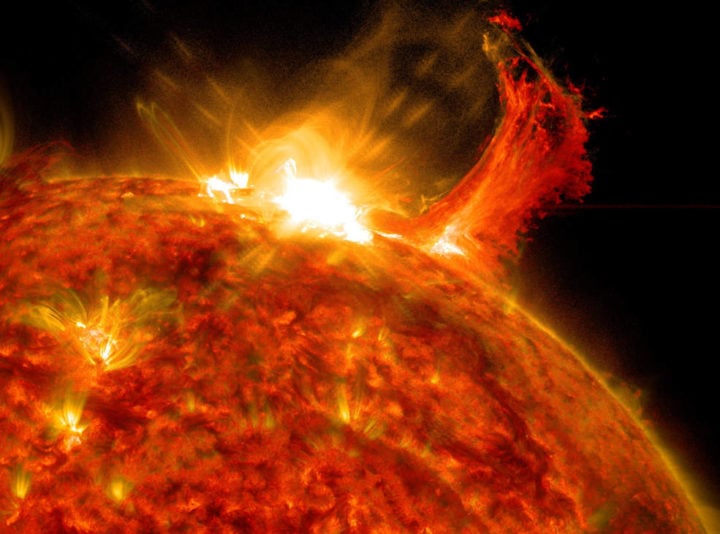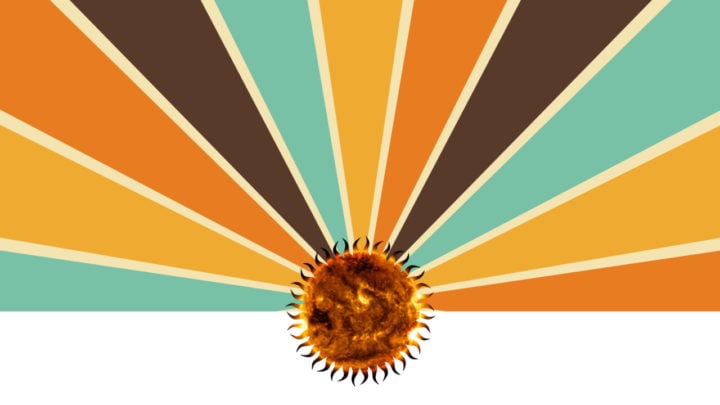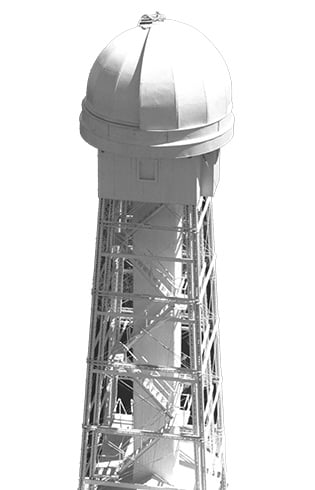A USC Dornsife physicist explains how the Earth’s future is tied to the star it orbits.

NASA’s Solar Dynamics Observatory captured this image of a solar flare on Oct. 2, 2014. The solar flare is the bright flash of light at top. A burst of solar material erupting out into space can be seen just to the right of it. Image Credit: NASA/SDO
In 1859, the Carrington Event, the most intense geomagnetic storm in recorded history, created spectacular auroral displays around the globe, illuminating the night skies so brightly that birds began singing and laborers set off for work, mistakenly believing the sun had risen.
Telegraph systems around the world — essential for communication at the time — began to fail as fires sparked and telegraph poles toppled, plunging the “Victorian Internet” into chaos. The cause? A massive solar flare with the energy of 10 billion atomic bombs was spewing electrified gas and subatomic particles toward Earth.

Solar activity – artistic interpretation. Image credit: USC
“Thankfully, we haven’t had anything that strong from the sun since,” says Edward Rhodes, a solar expert and professor of physics and astronomy at USC Dornsife. “But the worry now is: Will the sun generate such a severe event in the future that it will cause problems we just aren’t prepared for? Now everything is computerized — that would obviously have major consequences.”
Rhodes, who joined USC Dornsife in 1978, is a pioneer in the field of solar physics known as experimental helioseismology, which uses seismic techniques — similar to those employed by geophysicists in studying the Earth — to explore the internal structure and dynamics of the sun.
Rhodes is trying to understand whether the structure of the sun is changing in response to changes in the solar activity cycle. To do that, he and his team are studying sunspots — planet-sized regions of strong magnetic fields on the sun’s surface that appear darker because they are cooler than their surroundings.

NASA’s Solar Dynamics Observatory captured this image of a medium-class (M8.1) solar flare (bright area at right) on September 8, 2017. The image blends two different wavelengths of extreme ultraviolet light. Image credit: NASA/GSFC/SDO
“If we can improve our predictions concerning changes in the number of sunspots and the activity of the solar cycle, then we may be able to improve our knowledge of space weather and determine what is likely to cause major problems on Earth and what isn’t,” Rhodes says.
“There’s still a lot of variability from cycle to cycle in what the sun happens to be doing at any given time,” he says.
“By doing fundamental research on the sun as a star to learn more about how it’s changing, we can couple what we learn about those changes with research on space weather to determine whether a particular event will be as strong as in the same phase of the previous cycle, for example.”
Solar Cycles and Sunspots
Solar cycles were first observed in 1610 by Galileo, who also observed sunspots by pointing his small refracting telescope at a paper or cardboard surface and watching the bright disc of the sun, freckled with dark sunspots, move across it.
After observing several spots on the front hemisphere of the sun, he realized that when some disappeared only to reappear on the other side of the sun two weeks later, they were the same spots — they had simply been invisible from Earth because they were on the other side of the sun.
This information then enabled Galileo to calculate the rotation rate of the sun by measuring how rapidly these spots moved.
The celebrated Italian astronomer and his contemporary, English stargazer Thomas Harriot, were fortunate to be conducting their observations at a period of maximum solar activity.
Both had chanced upon a 35-year span of time before the sun went into an extended period of minimum activity, now known as the Maunder Minimum, when there were very few or no sunspots visible on the sun’s surface for about 70 years between 1645 and 1715.
During that period, the Northern Hemisphere of the Earth cooled slightly. Glaciers extended, rivers froze over and temperatures in major northern European cities dropped.
A New Maunder Minimum?

Constructed in 1908, the 60-foot Solar Tower Telescope on Mount Wilson has been operated by USC Dornsife’s Edward Rhodes, professor of physics, since 1978. Image credit: USC
Rhodes and his students have been investigating whether recent claims that the sun was heading for another Maunder Minimum might be true.
“The study of solar cycles shows that the number of sunspots on the sun peaked a number of years ago,” Rhodes says.
“As solar cycles became weaker, it began to look a little like a plot that was made of sunspots from Galileo and Harriot leading into that Maunder Minimum.”
Rhodes, assisted by his research group, has been operating the Mount Wilson 60-foot Solar Tower since he joined USC Dornsife in 1978. One of two solar telescopes at Mount Wilson, it is the only one still officially in operation.
Shortly after Rhodes arrived at USC Dornsife, NASA headquarters tapped him to join the European Space Agency team planning the Solar and Heliospheric Observatory (SOHO) spacecraft.
The completed spacecraft, which could point its cameras at the sun 24 hours a day, went into orbit in 1996. It became the primary spacecraft instrument until it was supplanted by the new 16-million-pixel camera system aboard the Solar Dynamics Observatory, launched in 2010.
Rhodes and his team used data from SOHO to study Cycle 23. Now, they are studying Cycles 24 and 25 with the Helioseismic and Magnetic Imaging experiment on the Solar Dynamics Observatory. Every two or three months, they receive new data that has been partially processed by Stanford University.
Rhodes’ students are trained to process that data so the team can see what the signature of these changes in the frequencies of the solar oscillations looks like at this solar cycle compared to the two previous ones.
“In the last year or so, we can see that maybe the sun isn’t going to be substantially weaker in this, our 25th solar cycle, than in the previous cycle, as was predicted,” Rhodes says.
“Also, the anticipated long-term absence of sunspots may not begin in the mid-2030s, as some experts had claimed, and might not occur until centuries in the future.”
Avoid Conflating Solar Activity With Climate Change
Rhodes cautions against linking solar activity with climate change or concluding that a new Maunder Minimum could help offset global warming.
“Because the Maunder Minimum occurred when there were changes in the Earth’s climate, I’ve been concerned that if the sun were to enter another extended 70-year minimum of activity, people would say, ‘See, we told you the sun is making the Earth now cool down a little, that in the past too much solar activity was warming the Earth,’ and that is not the case,” Rhodes says.
Even the small changes in the overall brightness of the sun or total solar irradiance — the amount of sunlight that reaches each square meter at the top of the Earth’s atmosphere every second — don’t appear to be enough to cause any long-term differences in climate.
Surprisingly, at the time when sunspots increase, which one would think would cause the sun to darken slightly, the total solar irradiance increases. Scientists think that, collectively, the non-spot portion of the sun’s atmosphere is brightening more than the sunspots are dimming.
“The fact that it gets brightest when there are the most spots on the sun and then gets a little fainter when there are fewer would mean that if we had 70 years of few spots, then the sun would be just a little fainter,” Rhodes says.
“Even a prolonged Maunder Minimum would only briefly, and minimally, offset human-caused warming, and global temperatures would quickly rebound once the event concluded.”
Source: USC

